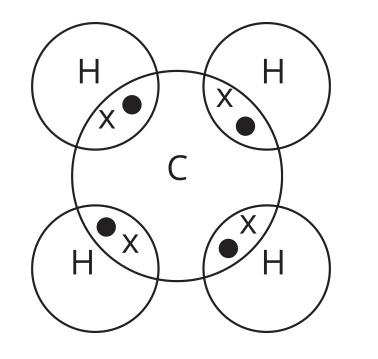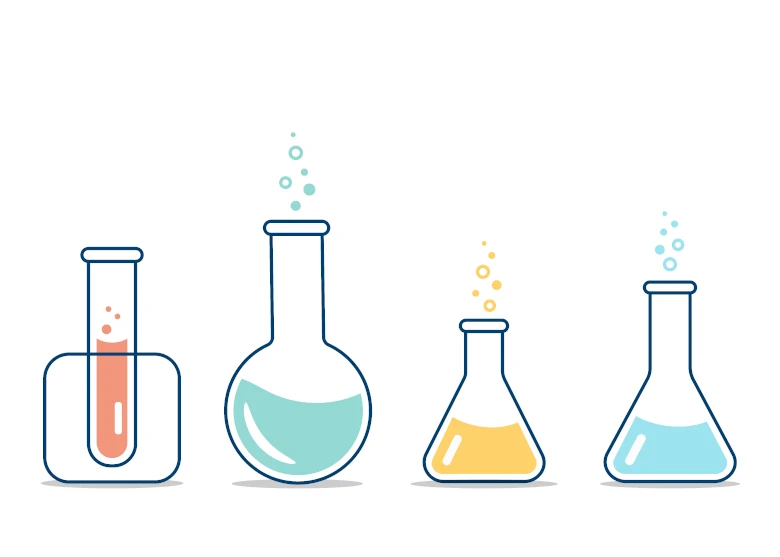Alkanes
In this article, we will cover the topic of Alkanes. These are the following learning outcomes:
- Describe alkanes as a homologous series of saturated hydrocarbons with the general formula \(\mathrm{C_nH_{2n+2}}\).
- Draw and name the first four alkanes.
- Explain why alkanes show a gradation in their physical properties down the homologous series.
- Describe the chemical properties of alkanes.
This article is aligned with the syllabus for Secondary 4 Chemistry students.
Alkanes Homologous Series
Alkanes are a homologous series of hydrocarbons that contain only carbon–carbon single covalent bonds.
Hydrocarbons are compounds that contain only hydrogen and carbon atoms.

General Formula Of Alkanes
\(\mathrm{C_nH_{2n+2}}\)
where \(\mathrm{n =}\) number of carbon atoms, which can take the value of \(1, 2, 3\) etc
There are two carbon atoms in the molecule shown in the diagram above. Given that \(\mathrm{n = 2}\), then
\(\begin{align} \mathrm{C_nH_{2n+2}} &= \mathrm{C_2H_{2(2)+2}}\\ &= \mathrm{C_2H_6} \end{align}\)
Saturated Hydrocarbons
Alkanes are saturated hydrocarbons because they contain only carbon–carbon single covalent bonds.

Each carbon atom uses all of its outer electrons in forming single covalent bonds with four other atoms. No new atoms can be bonded to the carbon atom. Therefore, the alkane is said to be saturated.
Let’s get to know the alkanes!
When naming the alkanes, the prefix tells us the number of carbon atoms in the molecule and the suffix tells us the homologous series the molecule belongs to. The homologous series here is alkane, hence, the suffix is ‘–ane’.
The table below shows the names and molecular formulae of the first four alkanes in the homologous series.
| Number Of Carbon Atoms | Prefix | Suffix | Name Of Alkane | Molecular Formula Of Alkanes |
|---|---|---|---|---|
| 1 | meth– | –ane | methane | \(\mathrm{CH_4}\) |
| 2 | eth– | –ane | ethane | \(\mathrm{C_2H_6}\) |
| 3 | prop– | –ane | propane | \(\mathrm{C_3H_8}\) |
| 4 | but– | –ane | butane | \(\mathrm{C_4H_{10}}\) |
Observe the molecular formulae of the first four alkanes in the series. Each member of the alkane homologous series differs from the next by a \(\mathrm{– CH_{2} –}\) unit.
In other words, each member of the alkane homologous series also differs from the next by a relative molecular mass of 14 (the sum of the relative atomic masses of 1 C atom and 2 H atoms).
Try It Yourself
Question 1:
An alkane is found to have 12 carbon atoms.
- Predict the molecular formula for this molecule.
- What is the molecular formula for the next member after this alkane?
Solution:
- The number of carbon atoms in the molecule is \(12\), which means \(\mathrm{n = 12}\).
Substituting \(\mathrm{n = 12}\) into the general formula of alkanes,
\(\begin{align} \mathrm{C_nH_{2n+2}} &= \mathrm{C_{12}H_{2(12)+2}}\\[2ex] &= \mathrm{C_{12}H_{26}} \end{align}\)
Therefore the molecular formula is \(\mathrm{C_{12}H_{26}}\).
- Each member of the alkane homologous series differs from the next by a \(\mathrm{– CH_{2} –}\) unit.
We can add a \(\mathrm{– CH_{2} –}\) unit to the molecular formula of \(\mathrm{C_{12}H_{26}}\) to obtain the molecular formula for the next member.
Upon adding \(\mathrm{CH_{2}}\) to \(\mathrm{C_{12}H_{26}}\), we get \(\mathrm{C_{13}H_{28}}\).
Alternatively:
We know that the next member will contain \(13\) carbon atoms in its molecule.
So, \(\mathrm{n = 13}\)
Substituting \(\mathrm{n = 13}\) into the general formula of alkanes
\(\begin{align} \mathrm{C_nH_{2n+2}} &= \mathrm{C_{13}H_{2(13)+2}}\\[2ex] &= \mathrm{C_{13}H_{28}} \end{align}\)
Structural Formula Of Alkanes
A structural formula shows how atoms are arranged in a molecule. It also shows the bonds between the atoms in a molecule.

Note: The structural formula can also be displayed in a condensed manner. For instance, the condensed formula of ethane can be written as \(\mathrm{CH_3CH_3}\). The condensed formula of propane can be written as \(\mathrm{CH_3CH_2CH_3}\) while that of butane can be written as \(\mathrm{CH_3CH_2CH_2CH_3}\).
Characteristics Of Alkane Homologous Series
Organic compounds in the same alkane homologous series have the following characteristics.
- They have the same functional group.
- They have similar chemical properties.
- They show a gradual change in their physical properties, such as melting point or boiling point, density, flammability, viscosity.
- They have the same general formula \(\mathrm{(C_nH_{2n+2})}\).
- Each member of the series differs from the next by a \(\mathrm{– CH_{2} –}\) unit.
Question 2:
Below are the names and the molecular structures of two alkanes.

What is the next alkane in the homologous series?
| Name | Formula | |
|---|---|---|
| (A) | butane | \(\mathrm{C_3H_6}\) |
| (B) | butane | \(\mathrm{C_3H_8}\) |
| (C) | propane | \(\mathrm{C_3H_6}\) |
| (D) | propane | \(\mathrm{C_3H_8}\) |
Solution:
(D)
Explanation:
The next member in this series is a molecule that contains 3 carbon atoms. The prefix for 3 carbon atoms is ‘prop–’. Hence, the name of the next alkane molecule in the series is propane. Given that \(\mathrm{n=3}\), we are going to substitute this value into the general formula of alkanes.
\(\begin{align} \mathrm{C_nH_{2n+2}} &= \mathrm{C_3H_{2(3)+2}}\\[2ex] &= \mathrm{C_3H_8} \end{align} \)
Question 3:
What is the molecular formula of octane, an alkane with 8 carbon atoms per molecule?
- \(\mathrm{C_8H_{14}}\)
- \(\mathrm{C_8H_{20}}\)
- \(\mathrm{C_8H_{18}}\)
- \(\mathrm{C_8H_{16}}\)
Solution:
(D) \(\mathrm{C_8H_{18}}\)
Explanation:
The number of carbon atoms in the molecule is \(8\), thus, \(\mathrm{n = 8}\).
Substituting this value into the general formula of alkanes, we get:
\(\begin{align} \mathrm{C_nH_{2n+2}} &= \mathrm{C_8H_{2(8)+2}}\\[2ex] &= \mathrm{C_8H_{18}} \end{align} \)
Question 4:
Which of the following statements about the homologous series of alkanes is not correct?
- They exhibit similar physical properties.
- They exhibit similar chemical properties.
- They can be represented by a general formula.
- They all contain only carbon and hydrogen atoms.
Solution:
(A) They exhibit similar physical properties.
Explanation:
Organic compounds in the same homologous series show a gradual change in the physical properties.
Physical Properties Of Alkanes
Melting And Boiling Points
| Name | Melting Point / °C | Boiling Point / °C | Physical State at r.t.p |
|---|---|---|---|
| methane | –182 | –162 | gas |
| ethane | –183 | –89 | gas |
| propane | –188 | –42 | gas |
| butane | –138 | –0.5 | gas |
| pentane | –130 | 36 | liquid |
The melting and boiling points increase as the molecular sizes increase from methane to pentane. This is because as the molecular sizes of the alkane molecules increase, the forces of attraction between the molecules also increase. More energy is needed to overcome these stronger forces of attraction.
Viscosity
Viscosity is a measure of a fluid’s resistance to flow. As the molecular sizes of the alkanes increase, the viscosity of the alkanes increases (in other words, the larger alkanes flow less easily).
This is because as the molecular sizes of the alkanes increase, there are more intermolecular forces between the molecules. In addition, as the length of the carbon chain increases, the molecules become more easily entangled.
Flammability
As the size of the molecules increase, the flammability of the alkanes decreases. This is due to the increase in the percentage by mass of carbon in the alkane molecules.
Let us compare the percentage by mass of carbon in methane and in pentane.
For methane \(\mathrm{(\,CH_4\,)}\)
Percentage by mass of carbon\(\begin{align}\\[2ex] &= \bigg[ \frac{12 \times 1}{12 \times 1 + 4 \times 1} \bigg] \times 100\% \\[2ex] &= 75\% \end{align}\)
For pentane \(\mathrm{(\,C_8H_{18}\,)}\)
Percentage by mass of carbon\(\begin{align}\\[2ex] &= \bigg[ \frac{12 \times 8}{12 \times 8 + 18 \times 1} \bigg] \times 100\% \\[2ex] &= 84.2\% \end{align}\)
The percentage by mass of carbon in pentane is higher than that in methane. Thus, pentane is less flammable than methane.
Larger molecules also burn with a sootier flame.
Question 5:
Which of the following physical properties of alkanes decrease(s) as the relative molecular mass increases?
- boiling point
- flammability
- melting point
- viscosity
- II only
- I and III only
- II and IV only
- II, III and IV only
Solution:
(A) II only
Explanation:
The flammability of alkanes decreases as the percentage by mass of carbon increases with increasing relative molecular mass.
Chemical Properties Of Alkanes
Alkanes are generally unreactive because of the strong \(\mathrm{C-C}\) and \(\mathrm{C-H}\) bonds, which are difficult to break. However, alkanes can undergo combustion and substitution reactions.
Combustion
Alkanes burn in excess air (oxygen) to produce carbon dioxide and water vapour.
Take methane as an example.
\(\mathrm{CH_4\;(g) + 2O_2\;(g)} \quad\xrightarrow[]{\qquad\qquad}\quad \mathrm{CO_2\;(g) + 2H_2O\;(g)}\)
The combustion of alkanes is highly exothermic. In other words, the reaction releases a large amount of heat energy. Hence, alkanes make very good fuels. Recall that the petroleum fractions such as petroleum gas, petrol, kerosene, diesel, are used as fuels for different purposes, such as for cooking, motorcars, aircrafts engines and diesel engines.
Substitution Reaction
Alkanes react with halogens (such as chlorine and bromine) in the presence of ultraviolet (UV) light.

The UV light catalyses the reaction by breaking the covalent bond between the chlorine atoms in the molecule. A hydrogen atom in methane is then substituted by a chlorine molecule to form chloromethane. The replaced hydrogen atom combines with the remaining chlorine atom to form hydrogen chloride gas.
In the presence of excess chlorine, more hydrogen atoms can be replaced with chlorine atoms to form a mixture of different substituted products.

Question 6:
One mole of methane was reacted with excess chlorine in the presence of UV light. How many moles of hydrogen chloride are formed?
- 1
- 2
- 3
- 4
Solution:
(D) 4
Explanation:
Each time a hydrogen atom in the molecule is replaced by a chlorine atom, a hydrogen chloride gas molecule is produced.
\(\begin{align} \mathrm{CH_4\;(g) + Cl_2\;(g)} \quad &\xrightarrow[]{\qquad\qquad}\quad \mathrm{CH_3Cl \;(g) + HCl\;(g)}\\[2ex] \mathrm{CH_3Cl \;(g) + Cl_2\;(g)} \quad &\xrightarrow[]{\qquad\qquad}\quad \mathrm{CH_2Cl_2 \;(g) + HCl\;(g)}\\[2ex] \mathrm{CH_2Cl_2 \;(g) + Cl_2\;(g)} \quad &\xrightarrow[]{\qquad\qquad}\quad \mathrm{CHCl_3 \;(g) + HCl\;(g)}\\[2ex] \mathrm{CHCl_3 \;(g) + Cl_2\;(g)} \quad &\xrightarrow[]{\qquad\qquad}\quad \mathrm{CCl_4 \;(g) + HCl\;(g)} \end{align}\)
| Continue Learning | |
|---|---|
| Metals | Introduction to Organic Chemistry |
| Alcohols | Speed of Reaction |
| Electrolysis | Energy Changes |
| Ammonia | Alkanes |
| Alkenes | Carboxylic Acids |


 SG
SG  VN
VN 
















